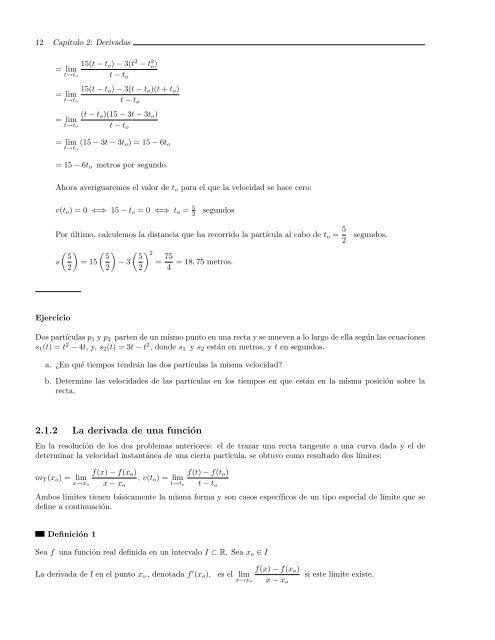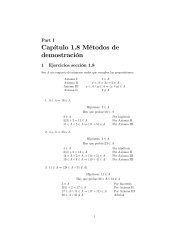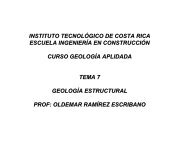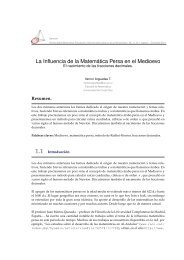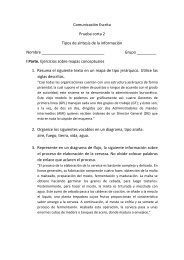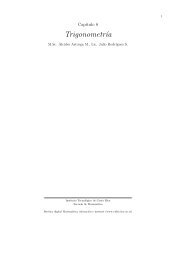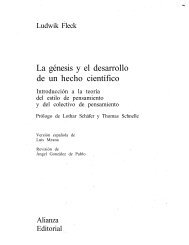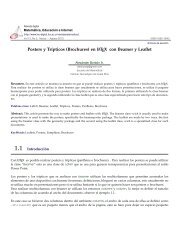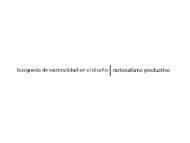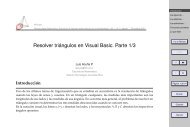Derivada de una función - TEC-Digital
Derivada de una función - TEC-Digital
Derivada de una función - TEC-Digital
You also want an ePaper? Increase the reach of your titles
YUMPU automatically turns print PDFs into web optimized ePapers that Google loves.
12 Capítulo 2: <strong>Derivada</strong>s<br />
15(t − to) − 3(t<br />
= lim<br />
t→to<br />
2 − t2 o)<br />
t − to<br />
15(t − to) − 3(t − to)(t + to)<br />
= lim<br />
t→to<br />
t − to<br />
(t − to)(15 − 3t − 3to)<br />
= lim<br />
t→to t − to<br />
= lim (15 − 3t − 3to) = 15 − 6to<br />
t→to<br />
= 15 − 6to metros por segundo.<br />
Ahora averiguaremos el valor <strong>de</strong> to para el que la velocidad se hace cero:<br />
v(to) = 0 ⇐⇒ 15 − to = 0 ⇐⇒ to = 5<br />
2 segundos<br />
Por último, calculemos la distancia que ha recorrido la partícula al cabo <strong>de</strong> to = 5<br />
2 segundos.<br />
2 5 5 5<br />
s = 15 − 3 =<br />
2 2 2<br />
75<br />
= 18, 75 metros.<br />
4<br />
Ejercicio<br />
Dos partículas p1 y p2 parten <strong>de</strong> un mismo punto en <strong>una</strong> recta y se mueven a lo largo <strong>de</strong> ella según las ecuaciones<br />
s1(t) = t 2 − 4t, y, s2(t) = 3t − t 2 , don<strong>de</strong> s1 y s2 están en metros, y t en segundos.<br />
a. ¿En qué tiempos tendrán las dos partículas la misma velocidad?<br />
b. Determine las velocida<strong>de</strong>s <strong>de</strong> las partículas en los tiempos en que están en la misma posición sobre la<br />
recta.<br />
2.1.2 La <strong>de</strong>rivada <strong>de</strong> <strong>una</strong> <strong>función</strong><br />
En la resolución <strong>de</strong> los dos problemas anteriores: el <strong>de</strong> trazar <strong>una</strong> recta tangente a <strong>una</strong> curva dada y el <strong>de</strong><br />
<strong>de</strong>terminar la velocidad instantánea <strong>de</strong> <strong>una</strong> cierta partícula, se obtuvo como resultado dos límites:<br />
mT (xo) = lim<br />
x→xo<br />
f(x) − f(xo)<br />
f(t) − f(to)<br />
, v(to) = lim<br />
x − xo<br />
t→to t − to<br />
Ambos límites tienen básicamente la misma forma y son casos específicos <strong>de</strong> un tipo especial <strong>de</strong> límite que se<br />
<strong>de</strong>fine a continuación.<br />
Definición 1<br />
Sea f <strong>una</strong> <strong>función</strong> real <strong>de</strong>finida en un intervalo I ⊂ R. Sea xo ∈ I<br />
La <strong>de</strong>rivada <strong>de</strong> f en el punto xo , <strong>de</strong>notada f ′ f(x) − f(xo)<br />
(xo), es el lim<br />
x→xo x − xo<br />
si este límite existe.


